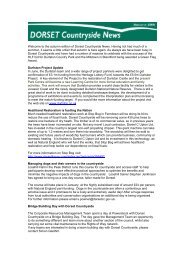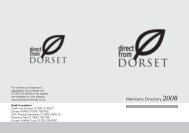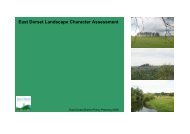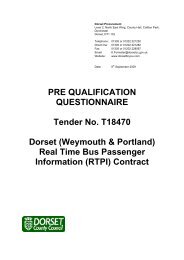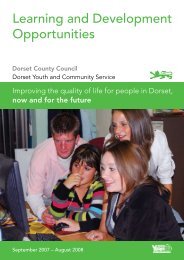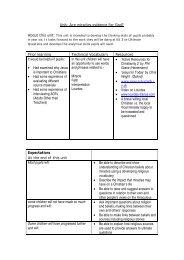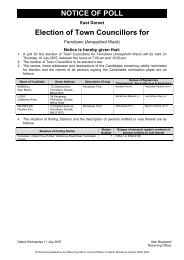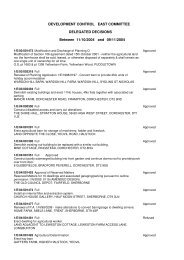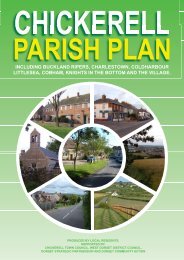Year: 5 and 6 Text type: Persuasive Writing ... - Dorsetforyou.com
Year: 5 and 6 Text type: Persuasive Writing ... - Dorsetforyou.com
Year: 5 and 6 Text type: Persuasive Writing ... - Dorsetforyou.com
You also want an ePaper? Increase the reach of your titles
YUMPU automatically turns print PDFs into web optimized ePapers that Google loves.
Building on previous learning:<br />
Differentiated expectations for a mixed age class would include:<br />
• Are familiar with advertisements <strong>and</strong> the persuasive devices used.<br />
• Able to organise information to support a point of view for both written <strong>and</strong> spoken<br />
presentations <strong>and</strong> debates.<br />
• Be familiar with connectives to structure a persuasive argument.<br />
• Able to design an advert such as a poster or radio jingle.<br />
Teaching Sequence<br />
Phase 1<br />
• Shared reading, evaluating <strong>and</strong> contrasting letters to a local newspaper based on<br />
local issue. E.g. new car park, supermarket etc.<br />
• Shared reading <strong>and</strong> evaluating fliers <strong>and</strong> brochures aimed at persuading the<br />
general public to a view point. E.g. ecological issues, nuclear power, global issues<br />
such fair trade<br />
• Read <strong>and</strong> evaluate letters, for example from newspapers or magazines, intended<br />
to inform, protest, <strong>com</strong>plain, persuade, considering (i) how they are set out, <strong>and</strong><br />
(ii) how language is used (e.g. to gain attention, respect, manipulate).<br />
• Select, read <strong>and</strong> evaluate a range of texts, in print <strong>and</strong> other media, on paper <strong>and</strong><br />
on screen (e.g. newspaper <strong>com</strong>ment, headlines, adverts, fliers) for<br />
persuasiveness, clarity, quality of information, <strong>and</strong> to <strong>com</strong>pare writing which<br />
informs <strong>and</strong> persuades, considering for example the deliberate use of ambiguity,<br />
half-truth, bias; how opinion can be disguised to seem like fact. Infer writers'<br />
perspectives from what is written <strong>and</strong> from what is implied.<br />
• Collect <strong>and</strong> investigate use of persuasive devices such as words <strong>and</strong> phrases<br />
(e.g. 'surely', 'it wouldn't be very difficult...') persuasive definitions (e.g. 'no one but<br />
a <strong>com</strong>plete idiot...', 'every right-thinking person would..., 'the real truth is...'),<br />
rhetorical questions (e.g. 'are we expected to...?', 'where will future audiences<br />
<strong>com</strong>e from...?'), p<strong>and</strong>ering, condescension, concession (e.g. 'naturally it takes<br />
time for local residents...'), deliberate ambiguities (e.g. 'probably the best...in the<br />
world', 'known to cure all...', 'the professional's choice').<br />
• Working in pairs sort collected words <strong>and</strong> phrases into categories e.g. suitable to<br />
use for particular audiences.<br />
• Play speaking <strong>and</strong> listening games where persuasion is used orally. E.g. hot air<br />
balloon debates, Room 101, what would you rather be … hammer or nail etc.<br />
Encourage the use <strong>and</strong> identification of key phrases used for persuasion.<br />
Phase 2<br />
• Construct an argument in note form to persuade others of a point of view,<br />
sequencing points logically. Explore how ICT or other use of multimodality might<br />
support this (e.g. develop a PowerPoint presentation). Present as a spoken<br />
argument to the class or a group making use of persuasive language. Listen to<br />
others doing the same <strong>and</strong> evaluate own <strong>and</strong> others' presentations.<br />
• Prepare an oral presentation for governors, headteacher or school council, on a<br />
school issue e.g. how an area of the playground should be developed, strategies<br />
for tackling bullying. Identify how language needs to change for different <strong>and</strong> more<br />
formal contexts.<br />
• Write a <strong>com</strong>mentary on an issue on paper or screen, for example as a news<br />
editorial or leaflet, setting out <strong>and</strong> justifying a personal view. Use structures from<br />
reading to set out <strong>and</strong> link points (e.g. numbered lists, bullet points).




